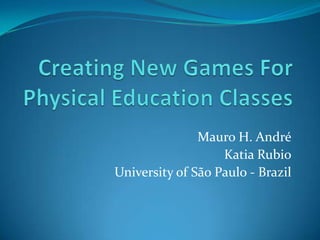
Creating new games for physical education classes
- 1. Mauro H. André Katia Rubio University of São Paulo - Brazil
- 2. Introduction The game, the child and the culture present an intense relationship, in which this study search for a better understanding. In order to illustrate the complexity of the game (and its relationship with other elements), we will be comparing the concept of image (picture) presented by Postman (1999) with the concept of the game. The image is unique and although it can be described with just a few words or more than a thousand of them, it can only be totally visualized and understand, once it is seen.
- 3. The complexity (keep this in mind) Would you be able to describe this image in words? What about your feelings when playing?
- 4. Introduction The 3 elements are present in a specific way: The game – is a social game (category presented by Piaget, 1986); The child – as a student; The culture – as the school culture (very specific).
- 5. Methodology This qualitative research was developed with a participatory action research methodology, once the researcher was also the students’ teacher. Throughout this approach, the present study described and analyzed the students attitude behavior while practicing many different games during their Physical Education classes.
- 6. The students 55 students participated on the research: 27 boys 26 girls All the students were 5th graders (age between 10 and 12 years old), and they were all new on the school, once they were from elementary schools on the previous year. They all lived in the city of Itapevi (25 Km from São Paulo) and had a low social-economic condition.
- 7. The school The school chosen was the biggest of the neighborhood and attended more than 2.000 students every day in three different periods (morning, afternoon and night). The public school attended both middle and high school (which is very common in Brazil). Unfortunately the school didn’t have enough resources to accommodate all the students well.
- 9. Research procedures The researcher worked (as a teacher) on the school in which the study was developed for one year. On the first semester, the researcher started the Physical Education program without collecting any data. On the second semester, the researcher videotaped almost all the classes. After viewing every tape (more than 10 hours in video), 4 classes were chosen to be used on the study. Four topics were selected to describe and analyze the videos: Conflicts, Respect of rules, Expressiveness and Competitiveness.
- 10. Transformed game - Dodge ball In the beginning of the year the students only knew about sportive games. As the year went by they had the opportunity to discover many others. After a whole semester learning new games they had the challenge to modify one specific game to create a new one (1st step).
- 11. Dodge ball – without cemetery Only two rules were modified: The elimination of the cemetery (changing the court division); The child that was hit by the other team should change team (instead of going to the cemetery).
- 12. Dodge ball – without cemetery The new rule introduced by the students in which each player would change team constantly was the biggest reason for the conflicts during this game Even though the students would see the cemetery as the biggest issue of the game. The game must respect the culture where it is played or else itself won’t be respected (Scaglia, 2002). Unlike other games, this dodge ball would create an atmosphere were the students wouldn’t feel unimportant if he/she wouldn’t get the ball as much as others did.
- 13. Dodge ball – with goals! The game remained with: the court division and one ball only; The players may also kick the ball (besides throwing); After hitting the opponent with the ball – they would play a penalty kick shootout (new climax). New player: goal keeper.
- 14. Dodge ball – with goals! Clearly the students tried to make the game of dodge ball more similar to the soccer game (national passion). The students will try to modify their activities into subjects that may be more meaningful to them (Darido & Rangel, 005). However what was surprising was their attitude behavior changing completely in order to reproduce the culture of soccer. The sportive games which are broadcast have a huge influence over their participants, influencing the way to play it, their behavior, and even their expressiveness (Betti, 2004).
- 15. Conclusions Many aspects can be point out for be responsible to determine the attitude behavior of children while they play games; nevertheless, this elements can only be determined once it is understood the relationship established between the game, the culture and the game itself. The game played in school must have a reflexive practice, where the students think about what are they learning and how they can modify their environment in order fit the games into their needs and not the order way around.
- 16. Thank you all for your attention My e-mail: mauro_ha@yahoo.com http://www.teses.usp.br/ Mauro Andre “O jogo no ambiente escolar”
